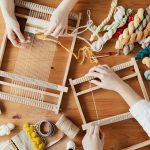If you've ever admired Penelope's weaving skills from The Odyssey, you'll appreciate the simplicity and satisfaction of DIY fabric projects. Starting with easy options like fabric coasters or no-sew pillows, you can progressively build your skills while creating useful and charming items. Imagine crafting custom book covers as thoughtful gifts or adding a personal touch to your home with fabric wall art. You don't need to be an expert to start; these projects are designed to be accessible and enjoyable. Ready to discover the joy of handmade creations?
Table of Contents
Key Takeaways
- Fabric coasters are perfect for beginners, using simple patterns like squares or circles.
- No-sew pillows provide a quick and easy project using fabric glue or iron-on adhesive tape.
- Simple tote bags made from canvas or denim offer a practical way to expand sewing skills.
- Custom book covers protect books and add a personal touch with easy sewing techniques.
- Fabric wall art enhances living spaces with textile paints, embroidery, or quilting.
Easy Fabric Coasters
Creating easy fabric coasters is a perfect way to begin your sewing journey. You'll find that crafting these small but functional items allows you to master basic techniques while exploring a variety of coaster designs. Start by selecting your coaster materials. Cotton fabric is a great choice because it's easy to work with and durable. You can also experiment with different textures like linen or felt for a unique finish.
When it comes to coaster patterns, simplicity is key. Square or circular shapes are beginner-friendly and provide ample space to practice straight stitching and turning corners. You'll find many coaster tutorials online that offer step-by-step guidance. These tutorials often include printable patterns, making it simple to cut your fabric to the correct size.
Don't hesitate to add your personal flair to your coasters. Playing with different fabric combinations and embellishments like embroidery or appliqué can make your pieces stand out. By following these coaster tutorials and experimenting with various coaster designs, you'll build confidence and refine your sewing skills. Remember, the goal is to enjoy the process and take pride in creating something both beautiful and practical.
Simple Tote Bags
Making a simple tote bag is an ideal next step for beginner sewers looking to expand their skills. You'll not only practice essential sewing techniques but also create a practical, stylish accessory. Tote bags are incredibly versatile and can be customized in countless ways to suit your taste and needs.
Here are the basic steps to create your tote bag:
- Select Your Fabric: Choose a strong fabric like canvas or denim. These materials provide durability and structure.
- Cut the Pieces: Cut two rectangles for the body and two long strips for the handles. Confirm the dimensions match your desired tote size.
- Sew the Body: With right sides facing each other, sew the sides and bottom of the rectangles. Press the seams for a polished look.
- Attach the Handles: Fold and sew the handle strips, then attach them to the inside of the bag opening, making sure they're evenly spaced.
Exploring tote bag variations can make your project even more exciting. Add pockets, linings, or use different fabrics for a unique touch.
Tote bag customization allows you to express your creativity—embellish with embroidery, patches, or fabric paint. Mastering these skills won't only enhance your sewing repertoire but also provide you with a functional, one-of-a-kind bag.
No-Sew Pillows
While sewing can be incredibly rewarding, crafting no-sew pillows offers a quick and easy way to add comfort and style to your home. With just a few materials, you can create beautiful, customized pillows without ever threading a needle. Start by selecting your desired fabric—cotton, fleece, or even an old pillowcase dress can work perfectly. Cut two equal-sized squares or rectangles, then use fabric glue or iron-on adhesive tape to secure the edges, leaving one side open for stuffing.
Add a personal touch with pillow embellishments. Use fabric bookmarks to create unique patterns or designs on the pillow's surface. This not only makes your pillows visually appealing but also showcases your creativity. For a more sophisticated look, consider adding fabric flower arrangements. Simply cut flower shapes from your chosen fabric and adhere them to your pillow using fabric glue.
Once your pillow is stuffed to your liking, seal the remaining edge with your adhesive method of choice.
In just a short amount of time, you've crafted a stunning no-sew pillow that enhances your décor and reflects your personal style. Whether it's for your living room or bedroom, these pillows are sure to impress.
Custom Book Covers
Transforming your preferred books with custom covers is a great way to safeguard them and showcase your distinctive style. Plus, crafting a fabric book cover is a simple project that produces professional outcomes.
Here's how you can craft your own personalized book covers:
- Measure Your Book: Unfold the book and measure the height and width of both the front and back covers, including the spine. Add an additional inch to these measurements for seam allowances.
- Cut Your Fabric: Choose a sturdy fabric that matches your style. Cut out a piece of fabric according to your measurements.
- Sew the Edges: Fold the edges of the fabric inward by half an inch and stitch them down to prevent unraveling. Next, fold the sides inward to form flaps that will secure the book covers in place.
- Assemble the Cover: Insert the front and back covers of your book into the fabric flaps. Adjust as necessary to guarantee a snug fit.
Personalized book covers make wonderful customized presents and can be combined with ornamental bookmarks for a considerate touch.
They're also perfect for safeguarding your educational materials and can be conveniently placed in your reusable shopping bags for reading on-the-go.
Fabric Wall Art
Creating fabric wall art is an excellent way to bring texture and color to your living space. Start with fabric painting to create bold, artistic statements. Use textile paints to craft unique designs, blending colors and shapes that resonate with your style.
For a more detailed approach, consider embroidery. Embroidery allows you to stitch intricate patterns and motifs, adding depth and personality to your wall art.
If you're inclined towards more structured projects, quilting offers a wonderful avenue. By piecing together various fabrics, you can create a patchwork masterpiece that's both visually striking and rich in texture. Experiment with different quilting patterns to achieve a balanced composition that enhances your room's aesthetic.
For those who appreciate traditional crafts, tapestry weaving might be the perfect fit. Using a simple loom, you can interlace threads to form elaborate designs and textured landscapes. The tactile nature of tapestry weaving provides a satisfying, hands-on experience, and the finished product offers a timeless elegance.
Each of these techniques—fabric painting, embroidery, quilting, and tapestry weaving—allows you to transform simple fabric into alluring wall art. Explore these methods to discover which resonates most with your creative vision.
Frequently Asked Questions
What Are the Best Types of Fabric for Beginners to Work With?
You should choose beginner friendly fabrics like cotton, flannel, and felt. These fabric types are easy to handle, don't fray much, and their characteristics make them perfect for simple projects. You'll build confidence quickly!
How Do I Properly Cut Fabric Without It Fraying?
Imagine a knight's armor protecting the fabric. Use fabric folding techniques and precise sewing machine settings. Guarantee you finish the fabric edge and incorporate generous seam allowances to prevent fraying and maintain a polished look.
What Basic Sewing Tools Should Every Beginner Own?
You'll want a sewing machine, sharp scissors, a seam ripper, and plenty of pins. Mastering these basic tools guarantees precision and efficiency, laying a solid foundation for more advanced projects in your sewing journey.
How Can I Avoid Common Mistakes When Sewing Fabric Projects?
Think of sewing as a dance with your machine. To avoid missteps, practice sewing machine troubleshooting. Let fabric project inspiration guide you, and you'll gracefully sidestep common errors, creating masterpieces with precision and flair.
Are There Any Online Resources or Tutorials for Learning Fabric Crafts?
You'll find plenty of online classes and tutorials to master fabric crafts. Join fabric craft communities and forums to connect with experts, share tips, and enhance your skills. These resources will elevate your craftsmanship substantially.
- What Is Pochampally Ikat? a Journey to India’s Silk City - June 27, 2025
- What Is Pochampally Ikat? a Journey to India’s Silk City - June 27, 2025
- What Is Pochampally Ikat? a Journey to India’s Silk City - June 27, 2025





